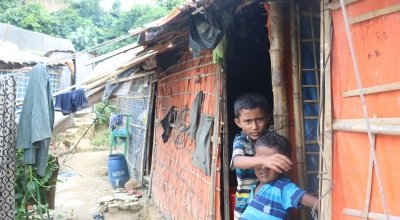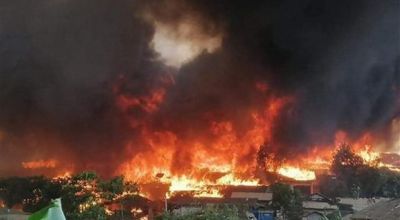
Read our 2023 annual report

Knowledge Hub
When Nurul Amin and his family fled the violence that broke out within Myanmar’s Rakhine State in 2017 and crossed the border into Bangladesh, they knew they were heading into an uncertain future.
What they could not have known, however, was that four years later they would remain in limbo, locked down in an unfamiliar country with their fellow refugees, with only the faintest hope of ever seeing their home country again.
Life, already difficult before the COVID-19 pandemic, has become even tougher for Nurul, his family and the entire Rohingya population living across 34 camps in Bangladesh’s Cox’s Bazar district.
The camps are now home to more than one million people, many of whom are infants and small children who have never seen the homeland of their parents.
Despite leaving the burning ruins of their homes to seek shelter in Bangladesh, the Rohingya have still not found a safe and secure home.
In 2021 alone, floods, fires, violence, repeated lockdowns and increasing tensions among previously hospitable neighbours have all made life more difficult.


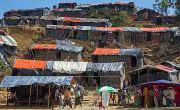
COVID-19 and the Rohingya population
When he made the arduous trip from Rakhine State to Bangladesh, Nurul was joined by six of his ten children and a number of his grandchildren.
His family - like many others - was split up during the exodus and subsequently settled into different camps in Cox’s Bazar district. However, they would move freely and meet regularly to try and make the adjustment to a new life as easy as possible.
That all ended with COVID-19.
Concern’s Emergency Director in Bangladesh, Heather Macey, describes how the speed of restrictions in 2020 initially benefitted the Rohingya community from a health point of view – to date, just 28 deaths have been officially recorded in the camps due to COVID-19 – but the hidden costs of restrictions continue to reverberate throughout Cox’s Bazar.
"The Rohingya in the camps experienced COVID through restriction and stopping of normal activities but less so in terms of health, due to the low numbers of people getting sick and dying,” Heather says.
“They saw all these additional restrictions coming into place, but they didn't really make much sense as people were still feeling well.”
One consequence of the measures was to stop people moving freely between camps.
"The restrictions have been eased every so often, but have never been removed. So there is a fear among the refugees that the restrictions, while put in place for a good reason, are now being used as a way to make life in the camp more restrictive, and reduce humanitarian access.”
Heather adds that the relatively low number of deaths lies in direct contrast to the increasing threat of the Delta variant. Getting the vaccination message out to a community who don’t feel they have been affected by COVID-19 is just one of a number of challenges facing health workers.
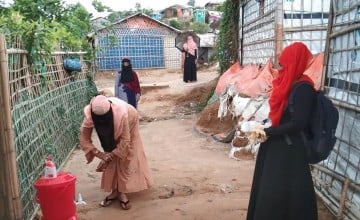
"We're now in Bangladesh's third wave with the Delta variant and, like the rest of the world, each new variant is more infectious and has a greater impact. It’s the same for the camp,” she says.
"It is getting worse, and people are getting concerned. It is great that the Bangladeshi government has started the rollout of the vaccination campaign for the elderly in the camps, and I hope it will continue to roll out to cover the rest of the refugees.”
Fire in the camps
Since March 2021, Nurul, his son Monir, Monir’s wife Khadija and their family have been living in a makeshift tent, after a massive fire destroyed more than 15,000 shelters.
Fencing and barbed wire - which was finished this year and surrounds the entire perimeter of the camps - blocked off potential routes of escape, and also left many injured older people and children separated from their families for days.
Khadija was herself separated from her three youngest children for two days, leaving her distraught. The fire also left tens of thousands of people without a home.
Speaking to Concern under a tarpaulin held upright by bamboo sticks, Khadija’s family describes how they were told they would receive new shelters by the time monsoon season started in June 2021.
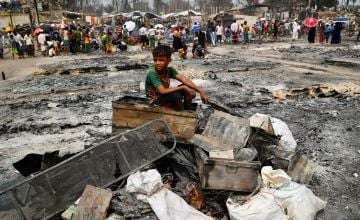
However, while the rains came, delays caused by COVID-19 restrictions around the camp meant that their shelter never did. They are left fearing the cold winter ahead, while Monir and Khadija's children and grandchildren have nowhere to play, no school, no games.
Alimul Islam is Concern’s Programme Manager for Emergency Response in Bangladesh, and he describes the difficulty of helping families like these in the current climate.
"In the last number of months, we have continued to face a lot of problems,” he says. “There have been strict lockdowns and the people who are working here have faced some difficulties.
"We have trouble getting permission to go to the camps, and then we also face problems with the community mobilisation activities.
"COVID is another emergency within the emergency of what's already happening within the Rohingya community here. Our staff and volunteers who provide support, they really find it very hard and they become afraid.”
It is a fear shared by both emergency workers and the wider Rohingya community in the region, and tensions – exacerbated by the fire, COVID-19 and the recent monsoon season - are rising.
Neighbours turning against each other
Monir and Khadija's eldest son Jafor lives just 100m from his parents with his young family.
With his house perched precariously on a small ledge between two other homes immediately above and below his, Jafor spent the recent floods terrified that his modest dwelling would slide downhill.
This was all while taking care of his three-day-old baby daughter.
Jafor has described how living in such perilous conditions, exacerbated by the regular monsoon conditions and being cut off from several members of his family, has caused tension between neighbours.
Skirmishes have recently broken out between Ismail and his nearest neighbours, with whom he had previously enjoyed a good relationship.
"They've lived quite harmoniously up until recently, and now he's saying that people are turning on each other,” says Heather Macey. “It's like a boiling pot, the more pressure you put in it, people are going to start feeling it."
Violence never feels far away.
The rise of gender-based violence
Fiona McLysaght is Concern’s Country Director for Bangladesh, and she says that cases of gender-based violence (GBV) are rising sharply within the Rohingya community.
“Lockdown has contributed to increasing levels of domestic violence. We see GBV cases increasing when people are in such confined areas," insists Fiona.
"The lockdown restrictions are having a huge impact on the safety, mental health and overall well-being of women and girls, and particularly now with the curtailment of education, protection and other support services.”
Concern operates a number of nutrition centres throughout the Rohingya camps, and we have recently installed fully-staffed protection desks at all of our sites, with referral mechanisms to those protection agencies who deal with GBV on an ongoing basis.
“We've tried, within the sphere of what we're doing in nutrition, to ensure that we ramped up the support we can offer to tackle the increased number of GBV and other violence,” adds Heather Macey.
Hope for the future fades
Since the military in Myanmar seized control of the country in February 2021, the dream of a return to their homeland remains elusive to Nurul, his children, his grandchildren and the entire Rohingya community in Bangladesh.
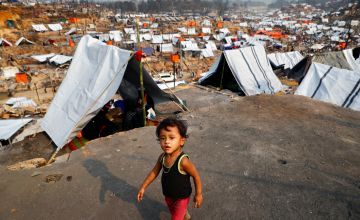
This is now a protracted crisis and hope is diminishing all the time within the Rohingya population.
"Take Jafor, both his children have been born in the camp,” says Heather.
“They've never been free. For parents to have no hope for your child because there's no education, there's no jobs, there's no cash, you don't even control what food you eat, [it’s a terrible thing].
"They're finding it harder and harder to really find those small bits of hope to cling on to.”
Turning the gaze of the world back on the plight of the Rohingya people is of the gravest importance.
"The reality is people are going to be at the camps for years,” adds Fiona.
“Unless there's some miracle, which is highly unlikely with what's happening now in Myanmar, people are stuck there for the longer term, so they're really stuck between a rock and a hard place."
“It's really, really difficult, and the camps situation is deteriorating. The population is increasing obviously every year. There are a million people in this confined area. It's very unpleasant, very troubling and a very fearful situation. What are we going to be discussing this time next year, five years on?”
Amid the uncertainty sits Nurul and his family.
His greatest wish is to see his grandchildren and great-grandchildren receive an education, for them to learn essential life skills and make life within the camp that bit easier, and perhaps one day become free again.
“We want to live in safety,” he says.
*Names have been changed for security
Read more about our work in Bangladesh
Concern has been working with the Rohingya community in Bangladesh since 2017. As part of our response, lifesaving nutrition services are being delivered by our emergency nutrition team to six camps in Cox’s Bazar - as well as support in the aftermath of challenges such as fires and monsoon rains.




